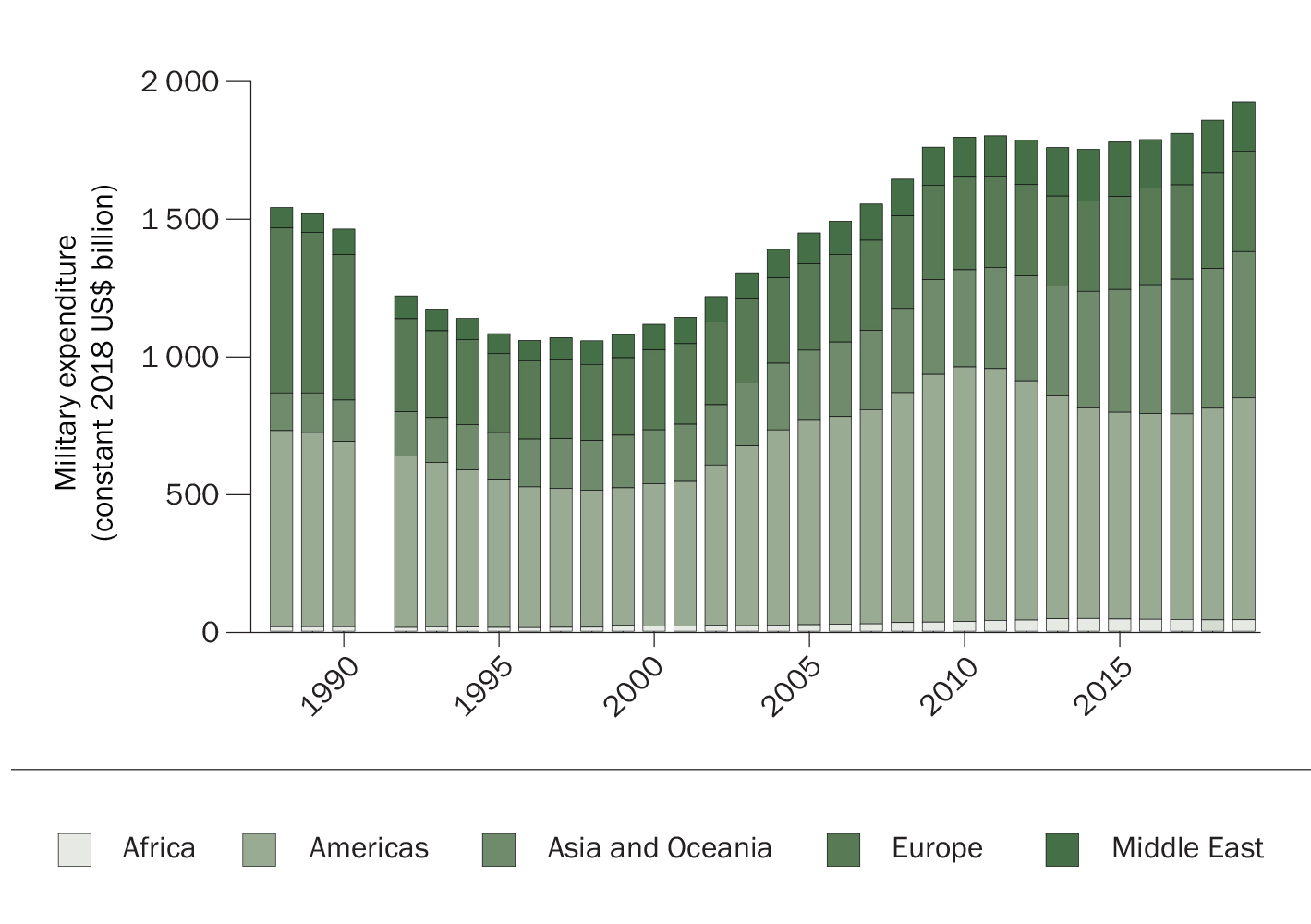ANALYSIS
Military spending sees biggest annual increase in a decade
Global military spending reached $1,917bn in 2019, a 3.6% increase on 2018 and the largest annual growth in the past decade, according to the Stockholm International Peace Research Institute (SIPRI). Harry Lye reports.
World governments spent roughly $249 per person on military expenditure in 2019, equivalent to 2.2% of global GDP, according to new data from SIPRI. The majority of this, 62%, came from the world’s top five spenders: the US, China, India, Russia and Saudi Arabia.
“Global military expenditure was 7.2 % higher in 2019 than it was in 2010, showing a trend that military spending growth has accelerated in recent years,” said SIPRI researcher Dr Nan Tian. “This is the highest level of spending since the 2008 global financial crisis and probably represents a peak in expenditure.”
Two Asian countries were among the top three defence spenders for the first time in 2019: China and India, which both increased defence spending last year.
The rest of the pack
The remaining top 10 defence spenders for 2019, according to SIPRI’s ranking, are as follows:
6. France: $50.1bn
7. Germany: $49.3bn
8. UK: $48.7bn
9. Japan: $47.6bn
10. South Korea: $43.9bn
“The growth in German military spending can partly be explained by the perception of an increased threat from Russia, shared by many North Atlantic Treaty Organization (NATO) member states,” said SIPRI researcher Diego Lopes da Silva. “At the same time, however, military spending by France and the United Kingdom remained relatively stable.”
Increasing by 10% in 2019, Germany’s military spending increased to $49.3bn, the biggest increase by percentage within the world’s top 15 defence spenders.
Excluding North Macedonia, which joined NATO this year, in 2019 NATO members spent $1,035bn. Overall defence spending across NATO continued to increase as more and more members strove to meet the recommended spend of 2% of GDP on defence budgets.
NATO expenditure also increased as a result of ongoing modernisations efforts, Bulgaria increased its defence expenditure by 127% largely due to aircraft purchases and Romania by 17%.

World military expenditure by region, 1988–2019. Notes: The absence of data for the Soviet Union in 1991 means that no total can be calculated for that year. Rough estimates for the Middle East are included in the world totals for 2015–19. Source: SIPRI Military Expenditure Database, April 2020.
Defence spending by region
1. Americas: $815bn
2. Asia and Oceania: $523bn
3. Europe: $356bn
4. Africa: $41.2bn
5. Middle East: no SIPRI estimate
1
2
3
4
5
1. US: $732bn
In 2019, the US increased its defence expenditure by 5.3% to a total of $732bn. This figure accounted for 38% of the entire worlds military spending. The US defence spending increase alone was the same as the military spend of Germany for the same period.
SIPRI senior researcher Pieter D. Wezeman said: “The recent growth in US military spending is largely based on a perceived return to competition between the great powers.”
2. China: $261bn
China spent $261 in the same period, a 5.1% increase on the previous year, building on 25 years of continuous growth in defence spending since 1994.
SIPRI said in the report: “The growth in its military spending has closely matched the country’s economic growth. Between 2010 and 2019, China’s military burden remained almost unchanged, at 1.9% of its GDP.”
3. India: $71.1bn
India continued to expand its military spending, largely owing to tensions with neighbouring Pakistan and China, which SIPRI senior researcher Siemon T. Wezeman called “major drivers for its increased military spending”.
In 2019, India’s defence spending rose to $71.1bn, which saw the country pull into third place as Saudi Arabia drastically cut its spending.
4. Russia: $65.1bn
In the same period, Russia expanded its military spending by 4.5%, climbing up the rankings as a result of Saudi Arabia’s decreasing spending.
SIPRI researcher Alexandra Kuimova added: “At 3.9% of its GDP, Russia’s military spending burden was among the highest in Europe in 2019.”
5. Saudi Arabia: $61.9bn
Saudi Arabia, in 2019, fell from the world’s third-biggest defence spender to the fifth, after a cut of 16% to military spending when compared to the year prior.
SIPRI said: “Saudi Arabia’s decrease and the increase in Russia’s spending (4.5%) meant that Russia moved up one place in the rankings, from fifth to fourth, while Saudi Arabia fell from third to fifth.”
